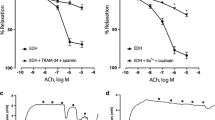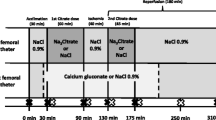Abstract
Most evidence for a key role of calcium entry in hypoxia-induced renal damage stems from studies with calcium channel blockers. In proximal tubules, a primary site of renal ischaemic injury, only phenylalkylamines, especially verapamil, have been studied. In the present study the effect of the dihydropyridine felodipine on hypoxic injury in isolated rat proximal tubules was investigated. To discriminate between the block of calcium entry and other effects, the enantiomers and a non-calcium blocking derivative of felodipine (H186/86) were included. Cell membrane injury was assessed by measuring the release of lactate dehydrogenase (LDH). At high concentrations (100 μM) felodipine, H186/86 and the two enantiomers all protected rat proximal tubules against hypoxiainduced injury to the same extent. Absence of extracellular calcium did not offer protection, but rather enhanced hypoxic injury. All dihydropyridines used increased the intracellular potassium concentration during normoxia. Felodipine attenuated the hypoxiainduced loss of cellular potassium. We have tried to mimic the effects of felodipine by using potassium channel blockers. The potassium channel blockers quinidine and glibenclamide afforded some protection against hypoxic injury, although their effects on cellular potassium were equivocal. We conclude that the dihydropyridine calcium channel blocker felodipine protects rat proximal tubules against hypoxic injury via a calcium-independent mechanism. We propose that high levels of intracellular potassium and attenuation of potassium loss during hypoxia are important in this protection.
Similar content being viewed by others
References
Almeida ARP, Bunnachak D, Burnier M, Wetzels JFM, Burke TJ, Schrier RW (1991) Time-dependent protective effects of calcium channel blockers on anoxia-and hypoxia-induced proximal tubule injury. J Pharmacol Exp Ther 260:526–532
Blank W, Unni Mooppan MM, Chhajwani B, Chou S-H, Kin H (1984) Effects of verapamil on preservation of renal function after ischemia: functional and ultrastructural study. J Urol 131:992–994
Bleich M, Schlatter E, Greger R (1990) The luminal K+ channel of the thick ascending limb of Henle's loop. Pflügers Arch 415:449–460
Burke TJ, Arnold PE, Gordon JA, Bulger RE, Dobyan DC, Schrier RW (1984) Protective effect of intrarenal calcium membrane blockers before or after renal ischemia. J Clin Invest 74:1830–1841
Chintala MS, Jandhyala BS (1992) Evaluation of the efficacy of felodipine in two models of acute renal failure in dogs. Kidney Int 41:S94-S99
Ferrari R, Cucchini F, Bolognesi R, Bachetti T, Boraso A, Bernocchi P, Gaia G, Visioli O (1994) How do calcium antagonists differ in clinical practice? Cardiovasc Drug Ther 8:565–575
Friedrich M, Benndorf K, Schwalb M, Hirche H (1990) Effects of anoxia on K and Ca currents in isolated guinea pig cardiocytes. Pflügers Arch 416:207–209
Galietta LJV, Rasola A, Barone V, Gruenert DC, Romeo G (1991) A forskolin and verapamil sensitive K+ current in human tracheal cells. Biochem Biophys Res Commun 179: 1155–1160
Gotoh Y, Imaizumi Y, Watanabe M, Shibata EF, Clark RB, Giles WR (1991) Inhibition of transient outward K+ current by DHP Ca2+ antagonists and agonists in rabbit cardiac myocytes. Am J Physiol 260:H1737-H1742
Hillyard SD, Van Driessche W (1992) Verapamil blocks basolateral K+ channels in the larval frog skin. Am J Physiol 262:C1161-C1166
Hosey MM, Lazdunski M (1988) Calcium channels: molecular pharmacology, structure and regulation. J Membr Biol 104: 81–105
Hurst AM, Beck JS, Laprade R, Lapointe J-Y (1993) Na+ pump inhibition downregulates an ATP-sensitive K+ channel in rabbit proximal convoluted tubule. Am J Physiol 264: F760-F764
Janero DR, Burghardt B (1989) Antiperoxidant effects of dihydropyridine calcium antagonists. Biochem Pharmacol 38:4344–4348
Kass RS (1987) Voltage-dependent modulation of cardiac calcium channel current by optical isomers of Bay K 8644: implications for channel gating. Circ Res 61:11–15
Kribben A, Wieder ED, Wetzels JFM, Yu L, Gengaro PE, Burke TJ, Schrier RW (1994) Evidence for role of cytosolicfree calcium in hypoxia-induced proximal tubule injury. J Clin Invest 93:1922–1929
Lowry OH, Rosebrough AL, Farr AL, Randall RJ (1951) Protein measurement with Folin phenol reagent. J Biol Chem 193:265–275
Mason RP (1993) Membrane interaction of calcium channel antagonists modulated by cholesterol: implications for drug activity. Biochem Pharmacol 45:2173–2183
Matsunaga H, Stanton BA, Gesek FA, Friedman PA (1994) Epithelial Ca2+ channels sensitive to dihydropyridines and activated by hyperpolarizing voltages. Amer J Physiol 267:C157-C165
McCarty NA, O'Neil RG (1991) Calcium-dependent control of volume regulation in renal proximal tubule cells: II. Roles of dihydropyridine-sensitive and -insensitive Ca2+ entry pathways. J Membr Biol 123:161–170
Pancrazio JJ, Viglione MP, Kleiman RJ, Kim YI (1990) Verapamil-induced blockade of voltage-activated K+ current in small-cell lung cancer cells. J Pharmacol Exp Ther 257:184–191
Reeves WB, Shah SV (1994) Activation of K+ channels contributes to hypoxic injury in proximal tubules. J Clin Invest 94:2289–2294
Rose UM, Bindels RJM, Jansen JWCM, van Os CH (1994) Effects of Ca2+ channel blockers, low Ca2+ medium and glycine on cell Ca2+ and injury in anoxic rabbit proximal tubules. Kidney Int 46:223–229
Schrier RW, Burke TJ (1991) Role of calcium-channel blockers in preventing acute and chronic renal injury. J Cardiovasc Pharmacol 18:S38-S43
Schwertschlag U, Schrier RW, Wilson P (1986) Beneficial effects of calcium channel blockers and calmodulin binding drugs on in vitro renal cell anoxia. J Pharmacol Exp Ther 238: 119–125
Shapiro JI, Cheung C, Itabashi A, Chan L, Schrier RW (1985) The effect of verapamil on renal function after warm and cold ischemia in the isolated perfused rat kidney. Transplantation 40:596–600
Spedding M, Paoletti R (1992) III. Classification of calcium channels and the sites of action of drugs modifying channel function. Pharmacol Rev 44:363–376
Thomine S, Zimmermann S, Van Duijn B, Barbier-Brygoo H, Guern J (1994) Calcium channel antagonists induce direct inhibition of the outward rectifying K+ channel in tobacco protoplasts. FEBS Lett 340:45–50
Tsuchiya K, Wang W, Giebisch G, Welling PA (1992) ATP is a coupling modulator of parallel Na,K-ATPase-K-channel activity in the renal proximal tubule. Proc Nat Acad Sci USA 89:6418–6422
Wetzels JFM, Burke TJ, Schrier RW (1992) Calcium channel blockers: protective effects in ischemic acute renal failure. Renal Failure 14:327–332
Wetzels JFM, Yu L, Wang X, Kribben A, Burke TJ, Schrier RW (1993) Calcium modulation and cell injury in isolated rat proximal tubules. J Pharmacol Exp Ther 267:176–180
Wibo M, Godfraind T (1988) Calcium entry blockers. In: Gerday C, Gilles R, Bolis E (eds) Calcium and calcium binding proteins Springer, Berlin Heidelberg New York pp 243–254
Author information
Authors and Affiliations
Rights and permissions
About this article
Cite this article
Peters, S.M.A., Tijsen, M.J.H., Bindels, R.J.M. et al. Protection against hypoxic injury of rat proximal tubules by felodipine via a calcium-independent mechanism. Pflügers Arch. 431, 20–27 (1995). https://doi.org/10.1007/BF00374373
Received:
Revised:
Accepted:
Issue Date:
DOI: https://doi.org/10.1007/BF00374373




